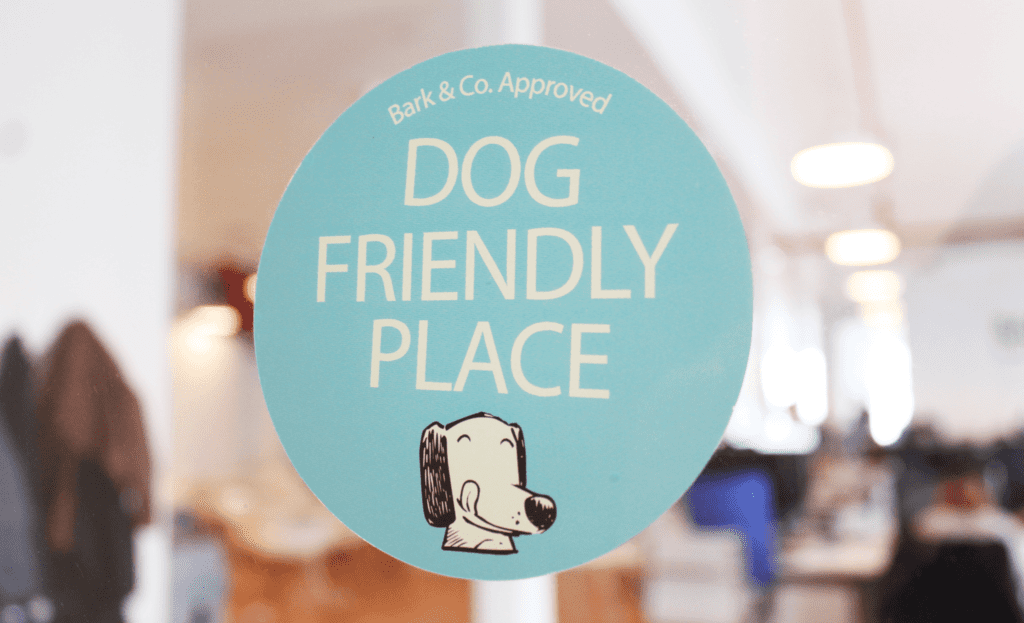5 Top Tech Solutions For Hybrid Companies
With over 50% of US workers working remotely at least once a week and tech solutions catching up quickly to meet the new challenges faced by modern businesses, hybrid workplaces... Read More

6 ways to save $$$ on your office space.
Learn more >July 28, 2018 | by
Reviewed by real estate expert Michael Colacino
Pet Sitters International celebrated the first annual Take Your Dog to Work Day on the Friday following Father’s Day in 1999. The original goals included raising awareness of the human-canine bond so that people without pets would be encouraged to adopt. But as employers and employees realized the benefits of having dogs in the workplace, the event has also played a role in sparking businesses to have pet-friendly policies all year round.
About 300 businesses participated in the first Take Your Dog to Work Day. Now, approximately 20% of U.S. companies have pet-friendly policies year round — and this number doesn’t include coworking spaces that allow pets. Many big name companies lead the pack in pet-friendly office policies, like Google, Amazon, Refinery29, Etsy, and Bark & Co.
Dogs are above and beyond the most common office space companion, so they will be the prime focus of this article, but there are plenty of other potential office pets to consider!
Creating a pet-friendly office should be a carefully thought-out decision. We’ve compiled the top things to consider as well as some pros and cons to keep in mind before opening your office space up to pets.

First, let’s be clear about one thing: having a pet-friendly office is not the same as having team members with support animals. Why? Service dogs are trained to perform a specific task to assist their owner with a disability and are legally allowed in places where your average pet dog is not. The types of service dogs you may encounter in the workplace include guide, hearing, mobility assistance, psychiatric service, diabetic or seizure alert, and allergy detection dogs.
It’s also important to recognize that emotional support dogs or other types of therapy dogs are not always classified as service dogs according to the Americans with Disability Act. This means if you have a firm no-pets policy at your office, you are likely under no legal obligation to allow employees to bring their emotional support dogs to work. (Some states, like California, do cover emotional support dogs under workplace disability laws, but there are limitations. We recommend looking into your state’s specific laws if you have questions.)
Unlike service dogs, emotional support dogs do not have any specialized training and are not necessarily limited to working with people with disabilities. While you might decide to adopt a policy that allows emotional support dogs in the office, this is still quite different from a pet-friendly policy that opens the office space to all employees who want to bring a pet to work.
As of 2017, millennials officially comprise more than one-third of the American workforce, making them the largest generation represented in labor force. There’s no doubt the newly dominant generation is influencing major trends in the workplace, from prioritizing company culture to embracing flexible work hours and remote work opportunities, to placing considerable value on work-life balance.
Given that millennials made headlines in the summer of 2017 when a survey from SunTrust showed that dogs made a more significant impact on millennials’ home-buying decision than either marriage or having children, it’s no surprise that the trend of bringing pets to the office (which we first covered in early 2017) continues to show no sign of slowing down.
Perhaps more than any generation before, millennials love their canine companions. Dogs are not just pets, they are beloved family members that influence how people live, work, shop and socialize. Outside of work, nearly 50% of millennials view their first pet as a “starter child” and like it or not, this dedication to their dogs is crucial to consider when weighing the pros and cons of a pet-friendly work environment.
Banfield Pet Hospital has conducted two Pet-Friendly Workplace PAWrometer™ (pets at work barometer) surveys since 2016 which show just how much influence pets have over their owners choice of workplace.
These numbers might make anyone pause to consider the benefits of implementing a pet-friendly office policy, but if you’re still not sure if you’re ready to welcome furry team members to the office keep reading to learn the most significant pros and cons of a pet-friendly office.
Pet owners are more than likely aware of some of the benefits that come with having a dog in their life, but for those who have little to no experience with pets or are unsure of how the benefits might transfer to the workplace, here are some of the most commonly touted pros.

If you already love pets, the pros of a pet-friendly office might seem incredibly persuasive, but there are an equal number of legitimate reasons why having a pet-friendly office may not be the best idea.
Before you consider a pet-friendly policy at your office, you should check your lease and seek input from your landlord. While your team might be ready for an office pet, you may find that bringing pets to work violates the lease or requires some form of pet deposit or extra fee.
Even if your landlord doesn’t allow pets, the good news is that interest in pet-friendly offices is on the rise. Your landlord may be open to negotiating the lease, or if your company is on the hunt for new office space, you can prioritize a pet-friendly space among your criteria.
Sara Groton, Eventbrite’s former Vendor Management Coordinator and Workplace Specialist, described how important a dog-friendly space was to the company’s search for a new office to Culture Amp:
“When we were looking for our new HQ, we had a handful of requirements that were non-negotiable: one of which was being able to bring dogs to the office, because the barklings (office dogs) are such a huge part of our culture here at Eventbrite. We almost had to pass on this space because we are in the UOP Dental School building, and they weren’t going to allow us to be dog-friendly. I will never forget when Julia Hartz (co-founder and president) told us about her two and a half hour-long meeting with the board of UOP solely to negotiate this policy. She is very persuasive! They compromised, and now we are allowed to have 5 dogs per day in the Briteland.”
While dogs can be great additions to many offices, there are certain kinds of workplaces that are simply not well-suited to pets. For instance, if your offices deal in any capacity with or are in close proximity to medicine, chemicals, or food, any benefits of having pets in the office will be negated by the contamination hazard that they pose.
However, if you’re confident pets will not pose a threat to your workplace, and your landlord says you can move forward, you’re ready to start ironing out your pet-friendly policy.
As shocking as it might seem, most pet-friendly workplaces do not have a formal pet policy. It’s essential to develop a clear pet-friendly policy, so all employees know exactly what to expect. For starters, it’s a good idea to follow a few ADA requirements, such as:
Other stipulations to consider in your pet policy include hygiene and health standards, obedience requirements such as proof of working with a professional trainer, and a rotating schedule instead of a free-for-all. Whatever guidelines you decide on, apply them consistently and fairly to each office pet.
On a dog’s first day at the office, have the employee come in early to introduce the dog to the space slowly. Send an announcement to the team leading up to the dog’s arrival to share information like dietary needs and behavioral patterns, along with a picture so that the dog is recognized.
Another important consideration is to make sure to carve out time for a mid-day walk. According to Nancy Scanlan, Executive Director of the AHVM Foundation, this helps prevent accidents in the office and the onset of cystitis, which can occur in dogs that are forced to wait too long to urinate.
Gathering input from your employees can also help shape your pet-friendly policy. Send out an optional and anonymous survey, and give your employees a deadline to share what they think. You may find out most of your employees don’t want pets around, or someone has a previously undisclosed allergy, or there are majority opinions about how many dogs should be allowed in the office per day.
Jeff Murphy, the Director of Communications at SnackNation, describes the company’s office pet policy as being “completely organic and employee-led. We really didn’t know what to expect at first, but we quickly found that it made our environment more fun and our business better.”
Murphy also says he was witness to another benefit of having a pet-friendly office: employees without pets are encouraged to rescue dogs and other pets of their own. If your day needs a little furry pick-me-up, check out the hashtag #adoptdontshop on Instagram to see the millions of lives saved by pet adoption.
| New York | Houston | Los Angeles | Dallas | Washington, D.C. |
| Austin | Chicago | Atlanta | Boston | San Francisco |
SquareFoot is a new kind of commercial real estate company. Our easy-to-use technology and responsive team of real estate professionals delivers the most transparent, flexible experience in the market. Get in touch to start your search today.